
Congratulations on Completing the Quiz!
Thank you for participating in our quiz on the most attended concerts in history! We hope you found the experience enjoyable and enlightening. It’s fascinating to learn just how many music lovers can gather for a single event, showcasing the universal power of music to bring people together.
Throughout the quiz, you might have discovered surprising facts about iconic performances and the artists behind them. Each concert is not just a gathering of fans but a moment in history that shapes how we experience live music today. Recognizing these milestones helps us appreciate the evolution of concert culture over the decades.
We invite you to deepen your knowledge with our next section, which explores the most attended concerts in history in detail. This will enhance your understanding of why these events became monumental. Join us for more insights, stories, and statistics about the incredible world of live music!

Most attended concerts in history
Overview of the Most Attended Concerts in History
The title of the most attended concert in history is often attributed to Rod Stewart’s performance on New Year’s Eve in 1994 at Copacabana Beach in Rio de Janeiro, Brazil. This concert attracted over 3.5 million people. Such massive attendance showcases the incredible draw of live music events, particularly in vibrant locations. Concerts that gather such crowds are rare and highlight the cultural significance of music in large gatherings.
Iconic Moments in Concert History
One of the most iconic moments in concert history occurred during the 1985 Live Aid concert. This global event featured legendary acts like Queen and U2, raising over $125 million for famine relief in Ethiopia. Queen’s performance, in particular, is often cited as one of the greatest live performances ever. The unity brought by this concert set a new standard for live fundraising events through music.
Significant Venues for Large Concerts
The Copacabana Beach in Rio de Janeiro is renowned for hosting massive concerts. Its open space facilitates unprecedented attendance figures. Other notable venues include the Central Park SummerStage in New York City and the G stadion in Istanbul, which are known for their large capacities and iconic performances. These venues contribute significantly to their respective cities’ musical landscapes.
The Evolution of Concert Attendance
Concert attendance has evolved over decades, with technology influencing how events are experienced. The advent of social media, for instance, has enhanced promotional efforts and ticket sales, increasing attendance. Iconic tours, such as Michael Jackson’s HIStory World Tour in 1997, showcased this trend, drawing millions as fans sought to experience live performances in person. Attendance figures have generally grown due to these advancements in communication and marketing.
The Role of Festivals in Attendance Records
Music festivals play a crucial role in concert attendance records. Events like the Woodstock Festival in 1969 and Coachella in California have drawn huge crowds, often multiple times the capacity of typical concert venues. Woodstock attracted around 400,000 attendees, highlighting the communal experience of music. Festivals combine numerous artists and genres, creating an expansive draw for fans worldwide.
What are the most attended concerts in history?
The most attended concerts in history include Rod Stewart’s 1994 New Year’s Eve concert in Copacabana Beach, Brazil, which attracted over 3.5 million people. Additionally, Jean-Michel Jarre’s 1997 concert in Moscow had around 3.5 million attendees, making both events top contenders for record attendance. Bruce Springsteen’s 1985 concert held in the Copacabana Beach also saw massive crowds, nearly matching these events in scale.
How is concert attendance measured for record-breaking events?
Concert attendance is typically measured by the number of tickets sold, as well as reports from event promoters and local authorities. In some cases, third-party organizations like Pollstar provide verification. For instance, the Guinness World Records maintains specific criteria for validating attendance figures, which includes verification through official documentation and eyewitness accounts.
Where did the largest concert in history take place?
The largest concert in history took place at Copacabana Beach in Rio de Janeiro, Brazil. Rod Stewart’s performance on December 31, 1994, drew an estimated crowd of over 3.5 million people, setting a record for the most attended concert. The beach’s extensive capacity allowed for such a large gathering, emphasizing its unique geographic location.
When did the record-breaking concerts occur?
The record-breaking concerts occurred at various times: Rod Stewart’s concert was on December 31, 1994, Jean-Michel Jarre’s concert took place on September 6, 1997, and the notable Bruce Springsteen concert happened on January 1, 1985. These concerts are significant for their extraordinary attendance figures and the cultural impact they left behind.
Who performed at the most attended concert in history?
Rod Stewart performed at the most attended concert in history during his New Year’s Eve show in 1994 at Copacabana Beach. His performance was notable for its massive crowd, estimated at over 3.5 million people. This record still stands as a testament to the drawing power of live music events on a grand scale.

